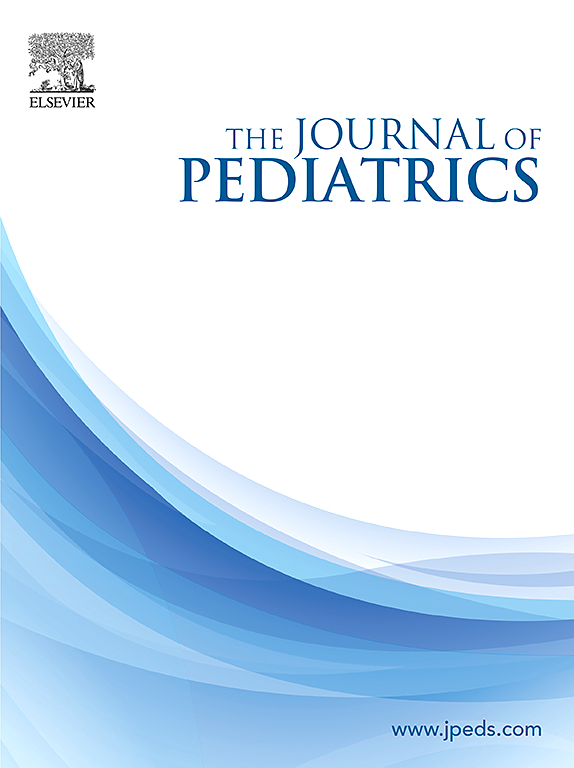发育障碍与未满足的儿童社会需求有关。
IF 3.5
2区 医学
Q1 PEDIATRICS
引用次数: 0
摘要
目的:比较儿童发育障碍(DD)患者与儿童初级保健(PC)患者自我报告至少一项健康相关社会需求(HRSN)的可能性。研究设计:这项横断面研究于2023年5月至2024年8月在纽约布朗克斯的一个大型城市卫生系统中进行。结果:约30.0% (n= 426)的DD患者自我报告至少1次HRSN,而PC患者为12.6% (n= 4064)。在多变量分析中,DD患者出现至少1次HRSN的几率比PC患者高2.49(2.20,2.82)。结论:卫生系统应考虑制定工作流程,以确定和解决小儿DD患者的HRSN问题。需要进一步研究,以了解导致DD患者HRSN患病率增加的因素。本文章由计算机程序翻译,如有差异,请以英文原文为准。
Developmental Disabilities Are Associated with Higher Unmet Social Needs in Children
Objective
To compare the likelihood of self-reporting at least one health-related social need (HRSN) for pediatric patients with developmental disabilities (DD) compared with pediatric primary care (PC) patients.
Study design
This cross-sectional study was conducted in a large urban health system in the Bronx, New York, between May 2023 and August 2024. We identified a cohort of patients ≤21 years old with DD (n = 1420), at an urban center that specializes in serving children with DD, who completed a standardized HRSN screener to assess housing insecurity, housing quality, utility needs, food insecurity, health care transportation needs, health care cost needs, child or adult care needs, and legal needs. We also identified a cohort of pediatric PC patients who completed the HRSN screener at 1 of 14 outpatient PC practices (n = 32 143). We completed a retrospective analysis using electronic health record data. Multivariable logistic regressions were conducted to estimate the likelihood of self-reporting at least 1 HRSN in regard to a patient's DD status, while adjusting for sociodemographic characteristics.
Results
Approximately 30.0% (n = 426) of DD patients self-reported at least 1 HRSN compared with 12.6% (n = 4064) of PC patients. In the multivariable analysis, DD patients demonstrated 2.49 (2.20, 2.82) greater odds of having at least 1 HRSN compared with PC patients.
Conclusions
Health systems should consider developing workflows that identify and address HRSNs for pediatric patients with DD. Further research is needed to understand the factors contributing to the increased HRSN prevalence observed in patients with DD.
求助全文
通过发布文献求助,成功后即可免费获取论文全文。
去求助
来源期刊

Journal of Pediatrics
医学-小儿科
CiteScore
6.00
自引率
2.00%
发文量
696
审稿时长
31 days
期刊介绍:
The Journal of Pediatrics is an international peer-reviewed journal that advances pediatric research and serves as a practical guide for pediatricians who manage health and diagnose and treat disorders in infants, children, and adolescents. The Journal publishes original work based on standards of excellence and expert review. The Journal seeks to publish high quality original articles that are immediately applicable to practice (basic science, translational research, evidence-based medicine), brief clinical and laboratory case reports, medical progress, expert commentary, grand rounds, insightful editorials, “classic” physical examinations, and novel insights into clinical and academic pediatric medicine related to every aspect of child health. Published monthly since 1932, The Journal of Pediatrics continues to promote the latest developments in pediatric medicine, child health, policy, and advocacy.
Topics covered in The Journal of Pediatrics include, but are not limited to:
General Pediatrics
Pediatric Subspecialties
Adolescent Medicine
Allergy and Immunology
Cardiology
Critical Care Medicine
Developmental-Behavioral Medicine
Endocrinology
Gastroenterology
Hematology-Oncology
Infectious Diseases
Neonatal-Perinatal Medicine
Nephrology
Neurology
Emergency Medicine
Pulmonology
Rheumatology
Genetics
Ethics
Health Service Research
Pediatric Hospitalist Medicine.
 求助内容:
求助内容: 应助结果提醒方式:
应助结果提醒方式:


